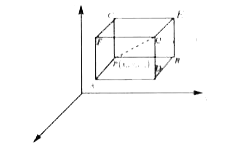Find the lengths of the edges of the rectangular parallelopiped formed by planes drawn through the points (1, 2, 3) and (4, 7, 6) parallel to the co-ordinate planes.Solution in Punjabi
Step by step video & image solution for Find the lengths of the edges of the rectangular parallelopiped formed by planes drawn through the points (1, 2, 3) and (4, 7, 6) parallel to the co-ordinate planes. by Maths experts to help you in doubts & scoring excellent marks in Class 11 exams.
Updated on:21/07/2023Topper's Solved these Questions
- INTRODUCTION TO THREE DIMENSIONAL GEOMETRYBOOK - MODERN PUBLICATIONCHAPTER - INTRODUCTION TO THREE DIMENSIONAL GEOMETRYEXERCISE - EXERCISE
86 Videos
- INFINITE SERIESBOOK - MODERN PUBLICATIONCHAPTER - INFINITE SERIESEXERCISE - EXAMPLE
10 Videos
- LIMITS AND DERIVATIVESBOOK - MODERN PUBLICATIONCHAPTER - LIMITS AND DERIVATIVESEXERCISE - EXERCISE
334 Videos
Similar Questions
A point is on x-axis. What are its y-co-ordinate and z-co-ordinate ?
View SolutionExpand (1−x2)−1/2 when | x | < 2.
View SolutionEvaluate the following limit if they exist :
limx→24.
View Solutionplanes are drawn parallel to coordinate planes through points (3,0,-1) and (-2,5,4). Find the length of the edges of parallelopiped so formed.
View SolutionPlane are drawn parallel to the coodinate planes through the points (3,0,-1) and (-1,5,4). Find the lenght of the edges of the parallelopiped so formed.
View SolutionA parallelopiped is formed by planes drawn through the points (1,2,3) and (-2,-2,-9) parallel to co ordinate planes.Then the volume of the rectangular parallelopiped is
View SolutionPlanes are drawn parallel to the coordinate planes through the points (1,2,3) and (3,-4,-5). Find the lengths of the edges of the parallelopiped so formed.
View SolutionPlanes are drawn through points (1,−3,4)and(4,7,−2) parallel to coordinate planes. Find the lengths of the edges of the rectangular parallelopiped so formed.
View SolutionPlanes are drawn parallel to the coordinates planes through the points (3,0,−1)and(−2,5,4). Find the lengths of the edges of the parallelopiped so formed.
View SolutionA parallelopiped is formed by planes drawn through the points (1,2,3) and (9,8,5) parallel to the coordinate planes. Then which of the followIng is not the length of an edge of the rectangular parallelopiped (A) 2 (B) 4 (C) 6 (D) 8
View SolutionA rectangular parallelopiped is formed by planes drawn through the points (5,7,9) and (2,3,7) parallel to the coordinate planes. The length of an edge of this rectangular parallelopiped is
View SolutionPlanes are drawn parallel to the coordinate planes through the points (1,2,3)and(3,−4,−5). Find th lengths of the edges of the parallelopiped so formed.
View SolutionFind the lengths of the edges of the rectangular parallelepiped formed by planes drawn throgh points (1,2,3) and (4,7,6) parallel to the co ordinate planes
View SolutionPlanes are drawn parallel to the coordinate planes through the points P (x1,y1,z1)andQ(x2,y2,z2) find the length of the edges of the parallopiped.

View SolutionPlanes are drawn parallel to the coordinate planes through the points (1,2,3)and(3,−4,−5). Find th lengths of the edges of the parallelopiped so formed.
View SolutionA rectangular parallelopiped is formed by planes drawn through the points (5,7,9) and (2,3,7) parallel to the coordinate planes. The length of an edge of this rectangular parallelopiped is
View Solution
